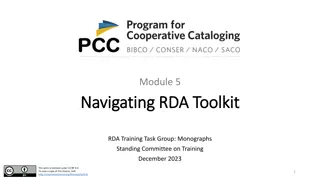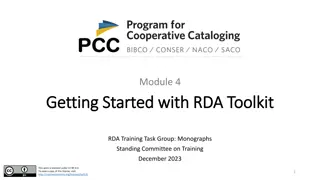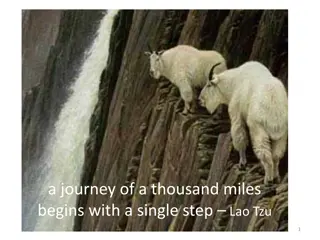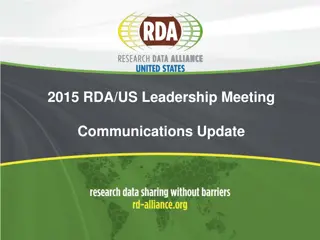Roadmap to Enable RDA Delivery: Plans and Preparation
Decision-making framework, journey consultation, phased return preparation, ongoing review, communication strategies for volunteers and participants, and key steps required by RDA National Office to ensure safety and compliance before riders can return on site are detailed in this comprehensive roadmap.
Download Presentation

Please find below an Image/Link to download the presentation.
The content on the website is provided AS IS for your information and personal use only. It may not be sold, licensed, or shared on other websites without obtaining consent from the author. Download presentation by click this link. If you encounter any issues during the download, it is possible that the publisher has removed the file from their server.
E N D
Presentation Transcript
Roadmap to Getting Started Plans and Preparation required to enable delivery of RDA
Our Decision Making Framework At all stages of our Roadmap to getting started we will make decisions based on the following : Is it safe? (recognising that working with horses comes with its own set of risks) Is it in line with our Government Guidelines? Is it in line with RDA National Office Guidelines? Will the resultant activity still be of benefit to our participants?
The Journey Consultation with Coaches, review of RDA NO materials, etc Developing safety approach for volunteers, riders and equines All planning work carried out remotely Planning Implementation of physical environment changes, signage etc Training of volunteers and equines, relevant forms completed. On site work begins with a very small team Preparation Phased Return Participans return in line with planning and prep Ongoing review of protocols Key to all of this will be how we communicate to volunteers and participants about the steps we are taking and how it will impact them.
Are We Nearly There Yet? Expectations of volunteers, participants & schools all need to be managed Expectation Frequent communication of RDA COVID19 rules, our plans & proposed timeline needed Communication All aware of phased return: Ponies > volunteer training > independent riders > quiet corner then group riding when possible Reality
What we need to do for RDA NO There are 5 key steps which have been set by RDA National Office which we need to be complete prior to any riders coming on site. Equine Assessment forms to be completed for all ponies we intend to use. 1. Volunteer consent forms to be completed (having completed the volunteer tool to help identify volunteers who can help) 2. Participant consent forms to be completed (having completed the rider tool to identify participants who can take part and who want to take part) 3. RDA COVID Risk Assessment to be completed 4. Trustee Checklist to be signed by Chair. This includes items on venue, particiapnts, horses, volunteers, etc. 5. Full details can be found at https://www.myrda.org.uk/runningyourgroup/getting- started-after-lockdown/
Planning phase 1 All completed remotely Things to consider Rider Journey from car park to horse and back again - identify safety protocols required for each step of the journey -use of spaces, hat fitting, mounting, dismounting, etc. Volunteer Journey from arrival identify safety protocols required for each step of the journey use of club room, tack room, collecting ponies, grooming, etc. Equine journey changes that will impact our ponies and what needs to happen - PPE, smell of handwash, getting back into work. Environment what does this mean to how we use the arena, gallery, clubroom, tie ups, headcollar room, etc. Cleaning protocols for equipment and touch points established. Work to be led by XXXXX. Consultation with Coaches and XXXXX. Plans to be signed off by Trustees before beginning phase 2.
Planning phase 2 All completed remotely Things to consider Participants who could we include bearing in mind protocols? Approach carers, schools, parents and explain new protocols and check whether they would want to take part or why they are not included in phase 1 returns. Volunteers contact all volunteers to determine who might want to come back and who doesn t. Also explain likely that we won t need everyone as reduced numbers etc. Equine journey identify which ponies will have work in phase 1 return. Consider plans for retiring extra ponies where appropriate. Environment identify what needs to be bought for PPE, handwash, signage, etc. likely costs identified. Work to be led by XXX. Consultation with Coaches and XXX. Plans and budget to be signed off by Trustees prior to any sessions beginning at the arena.
Preparation Sessions start at the arena, with social distancing maintained at all times Environment Purchase materials required, signage put up, hand wash hygiene facilities put in place, in line with Covid Risk Assessment. Participants who are coming issue forms for signing prior to attending. Volunteers establish teams and issue forms for signing prior to attending, essential training completed in small groups (only once environment is set up safely). Equines inform sharers, equine retraining and assessment begins. XXX to assess preparation for any additional actions Trustees to assess preparation, then sign off and return Trustee Checklist and Covid RA from RDA NO. Only when this is completed and signed off can we start any form of participant activity.
Questions for consideration Any feedback on slides? What s missing? Likely we will not be back to full class sizes within 12 months. Significant reduction in participant numbers will mean a lighter work-load for all ponies. Bearing in mind our fundraising restrictions, we will be looking at whether retiring some of our elderly ponies should be accelerated. The Trustees have asked the XXX to review the herd and make recommendations. Risk we lose volunteers however in the medium term we won t need as many? How do we try to keep them engaged?























